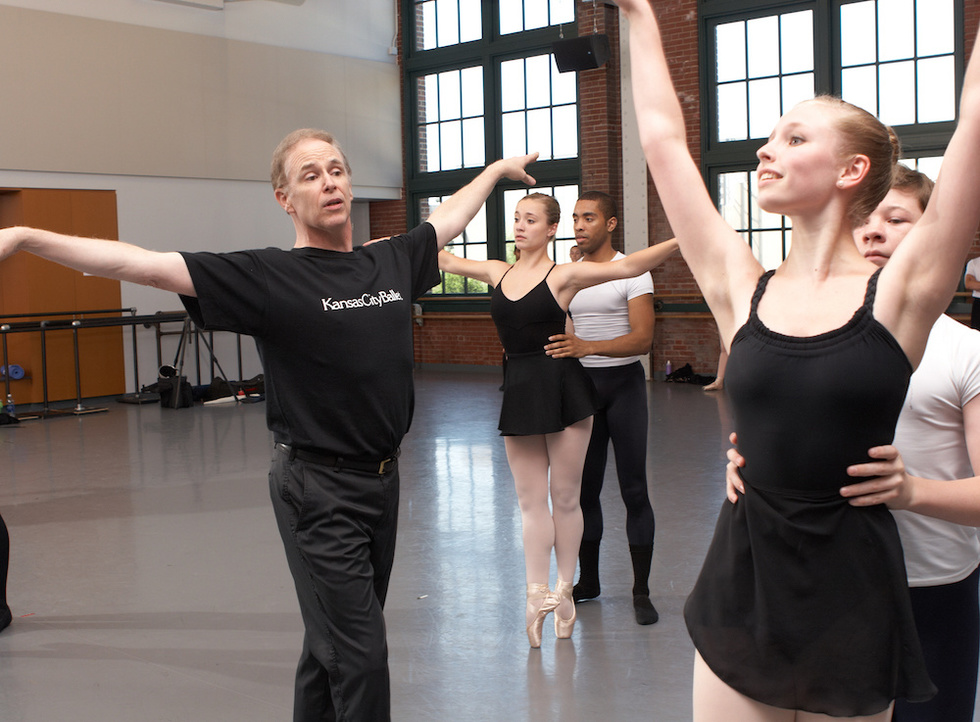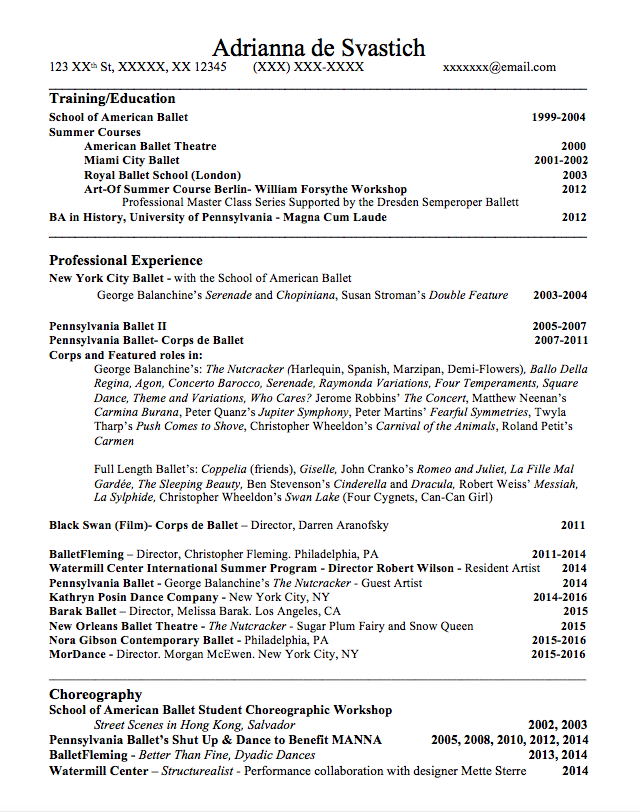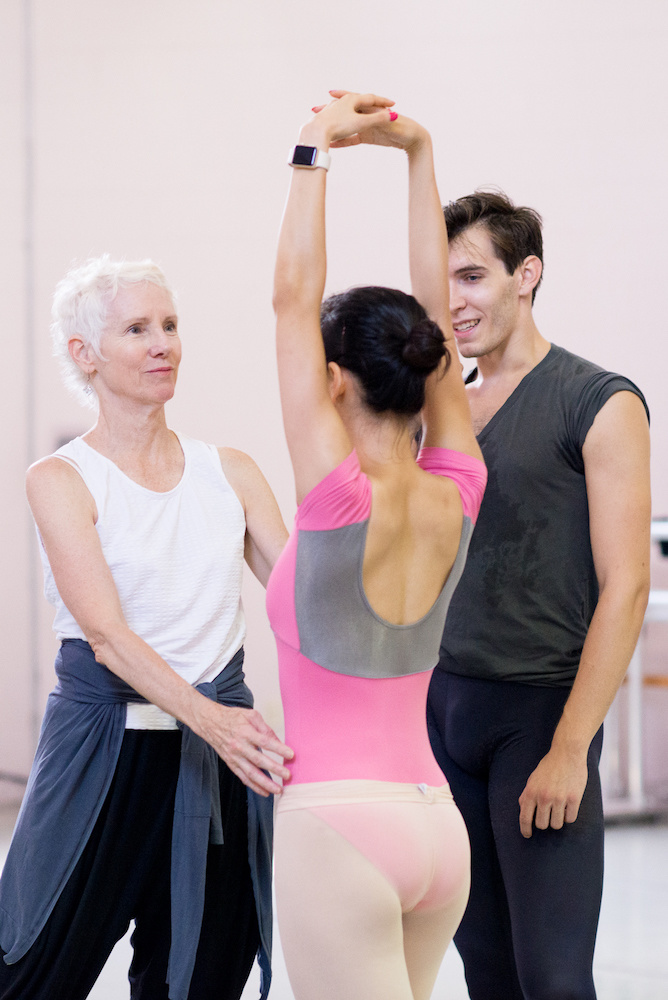
Artistic directors sift through hundreds of audition packets a season, and your resumé is often your first chance to catch their attention. Naturally, you want a document that makes a positive impression. But some surprising (and seemingly minor) details can inadvertently turn a director off. So, how do you make your resumé stand out—for the right reasons?
Focus on Essentials
At an audition, directors need to see your essential information at a glance: where you trained and what companies and choreographers you’ve worked with. Cincinnati Ballet artistic director Victoria Morgan scans for names she recognizes. “It’s good to know if a dancer has worked with a respected leader in the industry, and if there’s a colleague I can call as a reference. I’m also more inclined to take a second look at a student if I recognize a particular school or teacher,” she says.
Your resumé should be no longer than one side of one page. “When I’ve got 600 resumés sitting here, a three-page resumé is a disincentive to me,” says Kansas City Ballet artistic director Devon Carney. “It comes down to time—how quickly can you present your information to an unknown pair of eyes?”
 “I don’t need to know you did ‘Waltz of the Flowers’ for eight years,” says Kansas City Ballet artistic director Devon Carney. Photo by Ken Coit, Courtesy KCB.
“I don’t need to know you did ‘Waltz of the Flowers’ for eight years,” says Kansas City Ballet artistic director Devon Carney. Photo by Ken Coit, Courtesy KCB.
As for format, contact information should be at the top of the page. Make sure it’s accurate and up to date: Include your full name, address, phone number and an email address you actually use (and check daily—Carney cites opportunities dancers have lost because they didn’t respond promptly enough). Height is helpful to include, but weight, hair and eye color aren’t necessary. Since employment laws differ for minors, if you’re under 18 (or look like you could be), include your date of birth.
Next, list your work and training history. A common method is to organize everything in reverse chronological order, starting with your current job or school, with separate headings for training and professional performing experience. Putting each school, company or choreographer on a separate line using indentations or bullet points makes it easy to read. Repertoire and roles can either be noted alongside the school or company you performed them with or in a separate category. Morgan suggests including a link or two to any standout performances or studio work. List related experience (TV, commercial, modeling or theatrical work, for example), academic degrees, continuing education and any industry-related awards at the end.
Pennsylvania Ballet corps member Adrianna de Svastich opts to put her training at the top to illustrate her overall progression. “But it’s really about highlighting what best reflects you as a dancer and what you’re most proud of,” she explains.

De Svastich’s resumé, last updated in 2016, neatly fits on one page.
What Stays Out?
An impressive resumé doesn’t have to—and shouldn’t—include every credential you have, whether you’re an experienced professional or a student with only school shows under your belt. Prioritize what you’ve done and imagine what a director will really care about.
“Pedigree is important when you’re looking at who has influenced a dancer,” says Carney. That means listing the schools that primarily shaped your dancing, but not the studio where you took tap at age 3. Students and inexperienced professionals should include recognized summer programs, but naming the entire faculty (or whether you received a scholarship) is unnecessary.
Listing roles and repertoire gets tricky. Established dancers can fall into the trap of including too much in an effort to show how experienced they are, but an overly detailed list is unwieldy. “I don’t need to know you did ‘Waltz of the Flowers’ for eight years,” says Carney. “When I see featured roles, the assumption is you did corps work, as well. The important thing is to get a snapshot of where you are right now.” If you’ve only danced corps parts, include them, but edit it to highlight the most important or noteworthy ballets.

“Too much information may distract from aspects of your training or performing,” says Cincinnati Ballet artistic director Victoria Morgan. Photo by Jennifer Denham, Courtesy Cincinnati Ballet.
As her experience grew, de Svastich narrowed down her repertoire to only featured roles and added freelance projects, as well as film, commercials and her college degree. She includes her choreography work at the bottom.
It’s worth making room for “extras” if you feel they define you as a dancer or as a person. Morgan thinks a college degree signals maturity and independence, while Carney likes knowing if a dancer does volunteer or community work. But don’t overpack it: “Too much extra information may even distract from aspects of your training or performing that are important to know,” says Morgan.
Putting your life’s passion on a single page is hard, but crafting a concise resumé will leave directors with a lasting impression that reflects your achievements and your professionalism.
Bonus Tips: Resumé Do’s and Don’ts
Do:
- Proofread (twice!): Typos signal that you’re not conscientious. “It drives me nuts to see well-known choreographers’ or teachers’ names misspelled,” says Kansas City Ballet artistic director Devon Carney. (“Bournonville” and “Kylián” are frequently misspelled.)
- Include continuing education: Pennsylvania Ballet dancer Adrianna de Svastich includes a William Forsythe workshop she attended as a professional to show her effort to continue growing as an artist.
- Consider adding photos: A thumbnail headshot and dance shot in the upper corner of your resumé makes it stand out and helps a director quickly remember you.
Don’t:
- Mention hobbies and things you’re grateful for: “Resumés that are too full of information won’t hold my interest,” says Cincinnati Ballet artistic director Victoria Morgan.
- Leave unexplained chronological gaps or inconsistencies: Directors will wonder what you’re hiding if they see a time period with no training or work, or two schools attended during the same year.
- Be afraid of white space: If your essentials don’t fill an entire page, avoid plumping it up with extraneous tidbits.
- Include personal Instagram or Twitter handles: Unless you have an account or website that is solely professional, leave it off.



